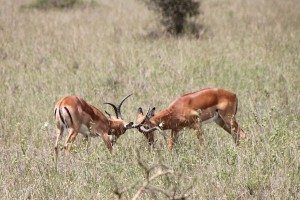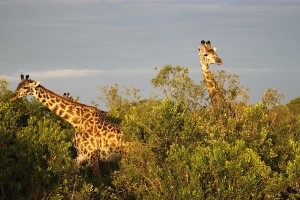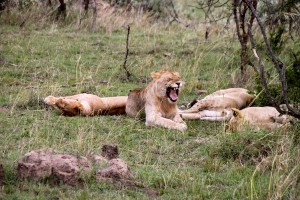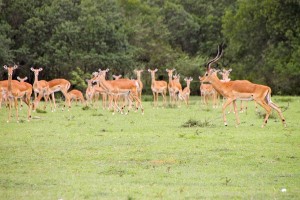This summer (2014), I watched two impalas butt heads while another closely guarded his harem, giraffes munch in the treetops, wildebeests run across a river by the hundreds, a young orphaned elephant drink milk from a bottle and sleepy lions yawn so broadly you could count their teeth.
And one very curious young elephant checked out the vehicle where I sat, by running his trunk over the windshield.
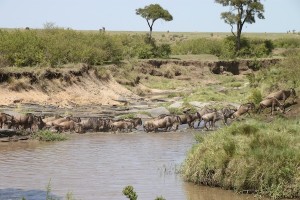
Hundreds of wildebeests hurry across the Ntiakitiak River on the Maasai Mara to get to fresher grazing. As with the Great Migration that takes millions of herbivores out of Tanzania’s Serengeti National Park toward Kenya’s Maasai Mara National Reserve, generally shortly after midyear, predators are watching and waiting.
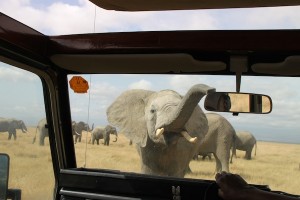
A young elephant investigates the strange vehicle in front of him, by running his trunk over the windshield. He is on the Kitirua Conservancy, adjacent to Amboseli National Park.
Most of the action occurred in the wild in or near Kenya’s Maasai Mara National Reserve and Amboseli National Park.
In the exception, the baby elephant was in an orphanage that sits in Nairobi National Park at the edge of Kenya’s capital city.
I was in Kenya as part of a press trip sponsored by the Kenya Tourism Board, with support from private travel companies. They brought in press from at least four countries — Canada, Russia, the U.K. as well as the U.S. — as part of a broader project to reassure overseas travelers and travel sellers that it is safe to go to Kenya, despite some widely reported violent incidents in the country.
The recent triggers for our trips were lethal mid-May bombs in a Nairobi market paired with warnings of impending extremist attacks on the coast. The latter led British tour firms to evacuate hundreds of their clients from Mombasa, a coastal resort.
Nevertheless, tourists have been traveling safely in Kenya. For one thing, the violence has not targeted tourists and has not surfaced in the places tourists love best, the game viewing areas.
The key is to buy travel from a reliable tour operator and give some thought to the itinerary. Travel agents who have frequently sold Kenya have not stopped; indeed, they remain dedicated to the destination.
However, at least based on my conversations with U.S. agents, they promote accommodations on Nairobi’s outskirts rather than in the middle of town, and they may not recommend traveling to the coast either.
We did not visit the coast (that was a shame, as risk factors don’t apply equally to all destinations on the Indian Ocean), but we were housed one night in a Nairobi city center hotel.
Regardless, security was tight around any Nairobi property we visited, whether downtown or in the suburbs. Security personnel, among other things, inspected arriving vehicles with a mirror on the end of a pole that they could position for views under vehicles.
But, in the game parks, the only issue is the animals, and they don’t pose risks as long as visitors are sensible. That means staying inside the open-sided touring vehicles unless, for example, on a guided walk or hosted to a meal in the bush. It also means relying on night guards in the tented camps when walking around after dark.
Even the self-described fraidy-cat in our group realized, to her astonishment, that she was relaxed even in the unfenced camps.
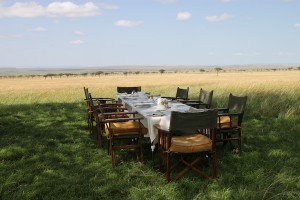
Breakfast in the bush is a typical treat offered by luxury safari camps. Sanctuary Olonana, a tented camp located on the Transmara Conservancy adjacent to the Maasai Mara National Reserve, prepared this one.
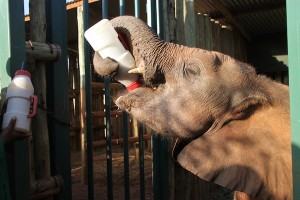
A young elephant taking his milk at David Sheldrick Wildlife Trust’s orphanage for elephants and rhinos, located in Nairobi National Park. Some babies, like this one, hold their own milk bottles.
For more about Kenya, we offer at BestTripChoices.com the following, under the headline: Of movies, and animals on the move https://besttripchoices.com/international-countries/kenya/
This blog and photos are by Nadine Godwin, BestTripChoices.com editorial director and contributor to the trade newspaper, Travel Weekly. She also is the author of “Travia: The Ultimate Book of Travel Trivia.”

